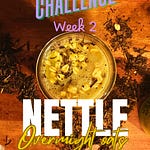(from the kitchen of someone who’s out of loose leaves, real cinnamon, and patience, but not ideas)
Earlier this week, we played with a bold base: Earl Grey. Floral meeting force. But today’s blend is different. I chose this one to show what happens when you don’t lean on a strong tea and pair two florals, side by side with green tea. No heavy flavors. Just softness and scent, layered together.
Jasmine and rose are both floral, but not in the same way. Jasmine is bright and a little heady. Rose is soft, sometimes a little bitter. So the question is,
do they balance each other? Cancel each other out?
What I used:
1 jasmine tea bag (because I’m out of the good stuff)
a pinch of dried rose petals
2 shakes of ground cinnamon (I’m also out of sticks. Don’t judge me)
Hot water
3 splashes of milk (oat for me but whatever you’ve got open)
optional sweetener (my milk is already sweetened)
How to make it:
Steep the jasmine tea and rose petals in hot water for 3-5 minutes and try it. Cover your cup while it steeps to keep the scent in. Keep steeping.
Add milk and cinnamon.
Strain the tea, then blend.
Sip and consider:
Are jasmine and rose dancing or dueling?
Is it too floral, or just enough?
What would you change next time?
How I turn this into a sleep tea:
Sometimes I add a scoop of magnesium glycinate powder to this blend, like in the video. I use magnesium glycinate because it’s the one that supports restful sleep.
(Magnesium oxide, on the other hand, is often used to correct magnesium deficiency but isn’t great for immediate nervous system support.)
This works well here because the blend is already soft.
Jasmine calms the mind, rose softens the edges, and magnesium fills in the nervous system piece without clashing with the flavors. It doesn’t compete. It just… lands quietly.
I use an unflavored kind that dissolves easily. Once the tea and milk are mixed and not too hot, I stir it in. That part matters if the water’s too hot, some magnesium powders clump or get weird. I learned that the annoying way.
It makes the tea do more without tasting like it’s trying to.
You can absolutely skip it.
Either way, jasmine and rose are already pulling in that direction. The magnesium just helps seal the deal.
Why this blend:
Herbalism is about using what you already have. You can always redo it later with better herbs, better milk, or real cinnamon sticks. But the best blends start exactly like this: with what you’ve got.
If this is your first time pairing florals together without a strong base tea, let yourself notice how they interact. Jasmine hits high and sweet. Rose softens it, or sharpens it, depending on how much you use. Cinnamon rounds it out or disappears behind the florals.
Let it sit with you. Then decide if you want to tweak the next cup.
Because not every tea needs a bold base to be memorable. This one is about subtlety. It’s about teaching your palate what floral-on-floral feels like. Sometimes they balance. Sometimes one overpowers the other.
This one’s gentle. Quiet.
Jasmine tea is a scented tea made by infusing tea leaves, usually green tea, but sometimes white or black, with the fragrance of jasmine flowers.
While it’s not herbal (because it uses actual tea leaves from Camellia sinensis), jasmine tea is often appreciated for its calming qualities and smooth taste.
And if you want to start your herbal journey without quitting halfway through, don’t forget that The Shit No One Tells You About Tea is available now.
It’s for the people
who feel like they’re always halfway through starting.
Who keep buying herbs but never know how to use them.
Who think they’re behind because their jars don’t match.
You’re not behind. You’re just missing the kind of guide that meets you where you already are.
Order to start where you are, and get a free herb & tea tracker (message me to let me know)!
Order here.
Dosage and Safety Considerations
The information provided in this newsletter is for educational and informational purposes only and is not intended as medical advice, diagnosis, or treatment. Herbal practices and uses discussed are not a substitute for professional healthcare.
While herbs are natural, they are also bioactive substances, and proper dosage, preparation, and use are important. Always follow reputable dosing guidelines for each herb and consult with a qualified healthcare provider before using any herbs, especially if you are pregnant, nursing, taking medications, have known allergies, or have existing medical conditions.
Anyone experiencing severe symptoms or managing chronic health issues should seek professional guidance before using herbs.
Individual responses to herbs may vary, and no outcomes are guaranteed. The author makes no claims regarding the effectiveness, safety, or suitability of any herb for any particular person.
Readers assume all responsibility for their personal health decisions based on the information presented. The author disclaims all liability for any loss, injury, or damage allegedly arising from the use or application of the information in this newsletter.
Camille Charles is the voice behind The Minimalist Herbalist. Herbal researcher. Best-selling author. Professional over-doer of tinctures. Consumer advocate. Currently earning a doctorate in curriculum design, on a mission to make herbal education less confusing and more honest.
She believes learning about herbs should feel empowering, not overwhelming. You’ll find her distilling rose water in an Instant Pot, repurposing olive jars for cacao butter, and making overnight nettle infusions like it’s a sacred ritual. She talks way too much about womb health, nettle, and why your juicer is probably lying to you.
If there’s an herb for it, she’s tried it, and probably turned it into a teachable moment.
Tea’s brewing. Grab a cup














Share this post